Abstract
1. Fatigue-associated electromyographic (EMG) reactions of intrinsic hand muscles were studied during maintained isometric voluntary contractions of normal subjects. Most measurements concerned actions of the first dorsal interosseus (FDI). In a smaller number of subjects, complementary measurements were obtained for adductor pollicis (AP). 2. Measurements were made of isometric force (thumb adduction, index finger abduction and flexion) and of surface EMG amplitudes (AP and FDI) after rectification and smoothing (rsEMG). 3. In the analysis of fatigue, the subjects were required to maintain a steady isometric force (index finger abduction or thumb adduction) of half their maximum voluntary contraction (1/2MVC test) for as long as possible. Average endurance times were 88 +/- 19 s (mean +/- S.D.) for FDI and 119 +/- 29 s for AP (Student's t test, P < 0.02). 4. Pronounced differences in fatigue-associated EMG behaviour were observed between AP and FDI. In AP the reaction was as expected: a rise of EMG during maintained force (mean rsEMG at end of fatigue test/mean rsEMG at start of test (rsEMG-FI): 181 +/- 64%). In FDI this reaction was seen in half of the recorded cases, the remainder displaying bidirectional changes or a more or less marked decrease of EMG during the endurance task (mean for all cases together: rsEMG-FI, 103 +/- 15%; difference between AP vs. FDI significant, P < 0.01). 5. The unexpected EMG variability of the FDI reactions was further analysed with multiple bipolar recordings of surface EMG. For all the four thoroughly studied subjects, recordings were obtained which showed simultaneously occurring EMG changes in opposite directions (decrease and increase) at different sites of FDI while force was kept constant at 50% of the maximum voluntary contraction (MVC). 6. Further observations on FDI showed that EMGs simultaneously obtained from different recording sites could show dramatic differences in their responses depending on 'synergistic context' (e.g. in relation to changes in index finger extension force during maintained abduction at 50% MVC). Evidence for 'task switching' (shift in rsEMG distribution, shift in hand muscle synergy) was frequently observed during the performance of the 1/2MVC test. 7. The results indicate that FDI is not handled in a topographically homogeneous manner during the execution of an isometric constant force endurance test. Furthermore, the results suggest that this seemingly simple motor performance can be executed in several alternative manners associated with the activation of different muscle synergies and with different distributions of activity within the FDI.
Full text
PDF
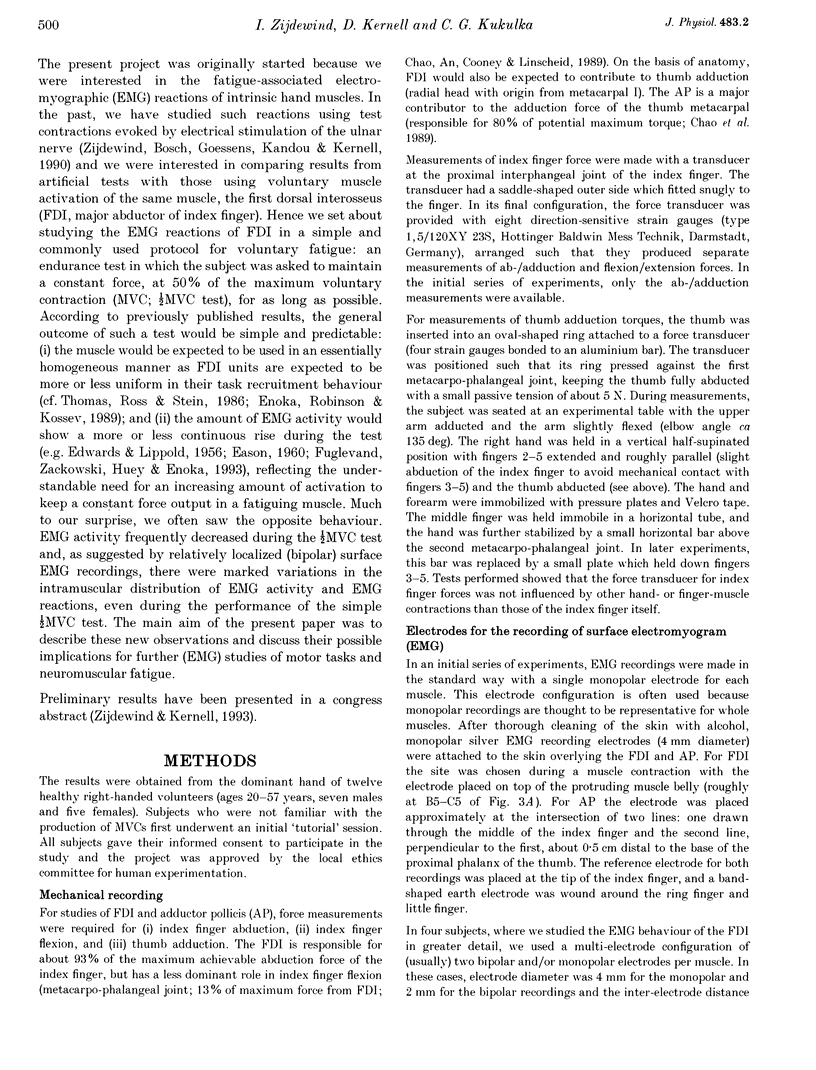
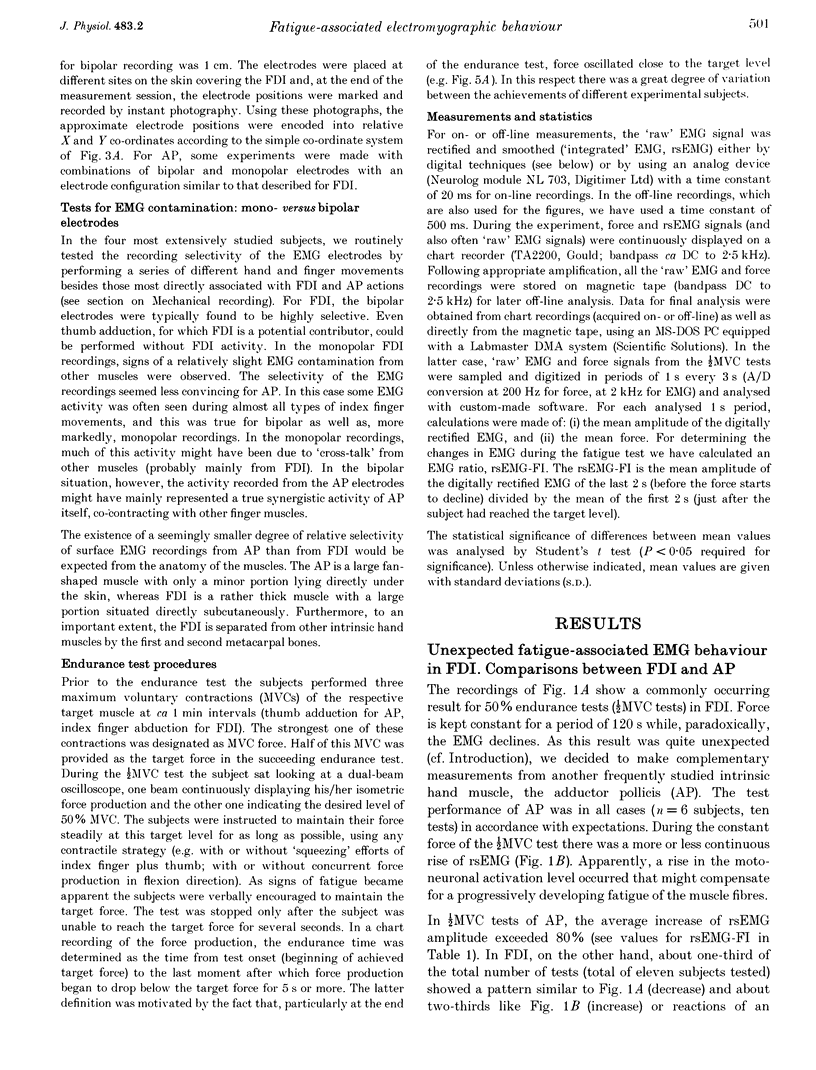

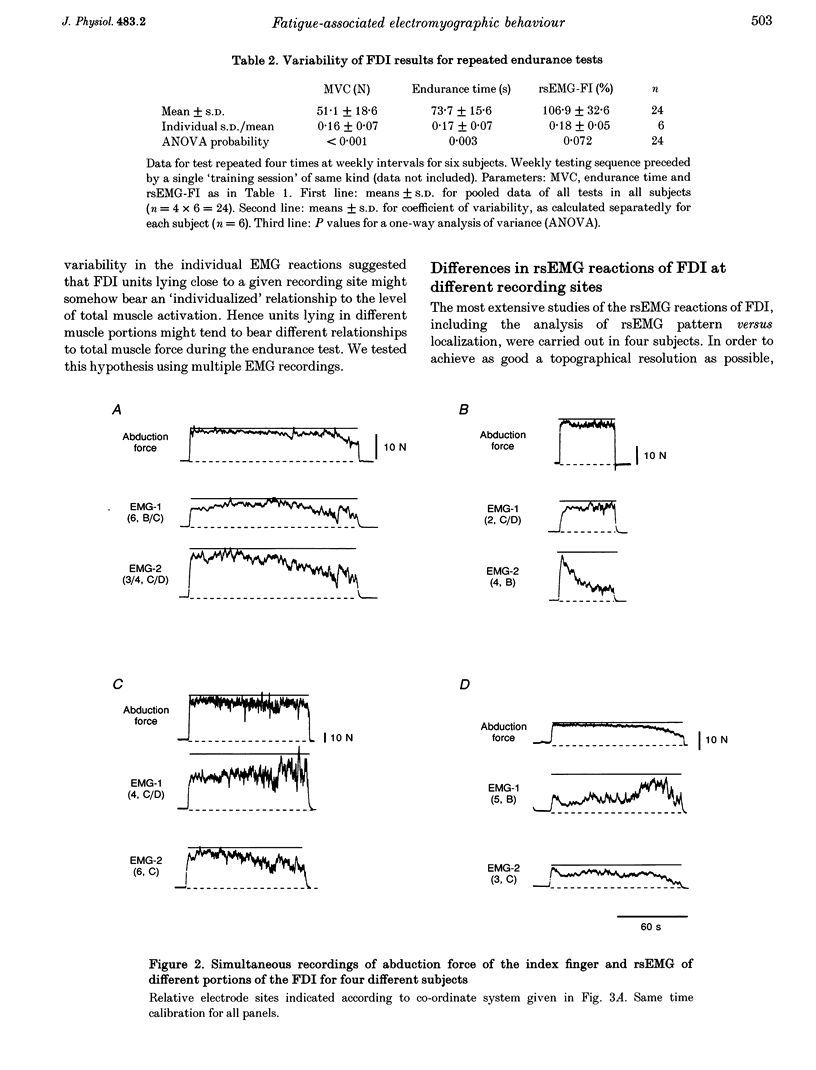


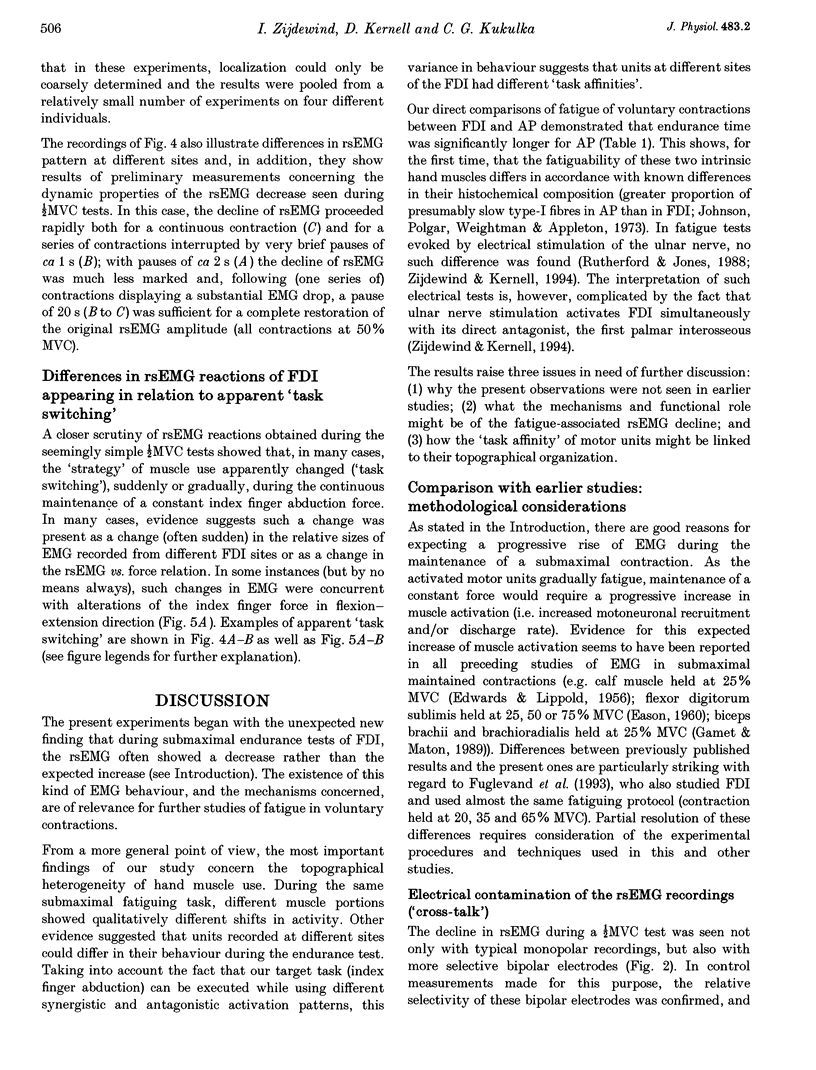

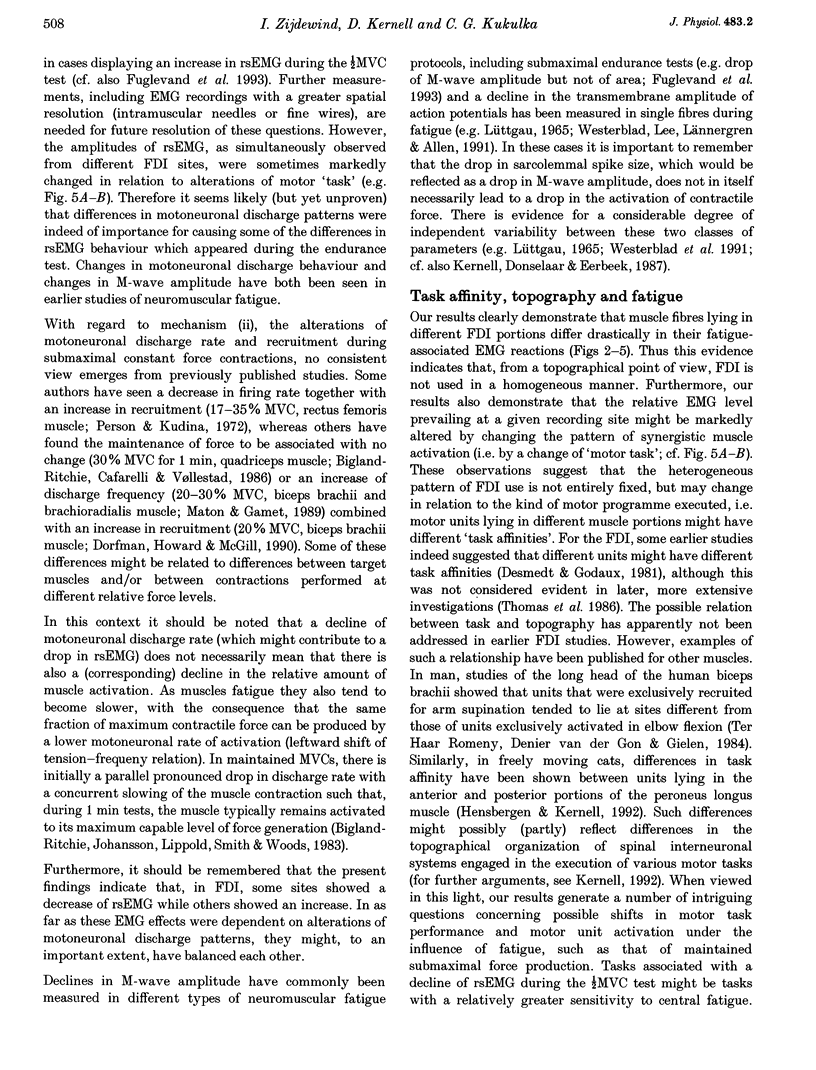
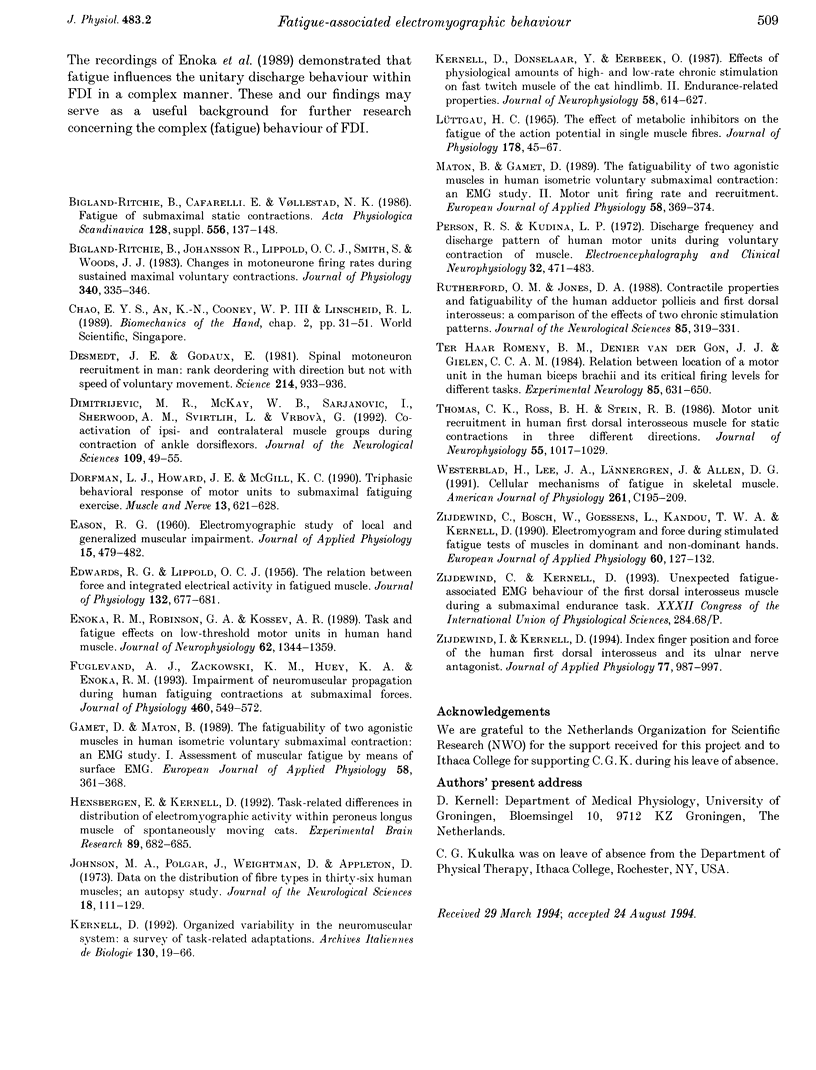
Selected References
These references are in PubMed. This may not be the complete list of references from this article.
- Bigland-Ritchie B., Cafarelli E., Vøllestad N. K. Fatigue of submaximal static contractions. Acta Physiol Scand Suppl. 1986;556:137–148. [PubMed] [Google Scholar]
- Bigland-Ritchie B., Johansson R., Lippold O. C., Smith S., Woods J. J. Changes in motoneurone firing rates during sustained maximal voluntary contractions. J Physiol. 1983 Jul;340:335–346. doi: 10.1113/jphysiol.1983.sp014765. [DOI] [PMC free article] [PubMed] [Google Scholar]
- Desnedt H. E., Gidaux E. Spinal motoneuron recruitment in man: rank deordering with direction but not with speed of voluntary movement. Science. 1981 Nov 20;214(4523):933–936. doi: 10.1126/science.7302570. [DOI] [PubMed] [Google Scholar]
- Dimitrijevic M. R., McKay W. B., Sarjanovic I., Sherwood A. M., Svirtlih L., Vrbovà G. Co-activation of ipsi- and contralateral muscle groups during contraction of ankle dorsiflexors. J Neurol Sci. 1992 May;109(1):49–55. doi: 10.1016/0022-510x(92)90092-y. [DOI] [PubMed] [Google Scholar]
- Dorfman L. J., Howard J. E., McGill K. C. Triphasic behavioral response of motor units to submaximal fatiguing exercise. Muscle Nerve. 1990 Jul;13(7):621–628. doi: 10.1002/mus.880130711. [DOI] [PubMed] [Google Scholar]
- EASON R. G. Electromyographic study of local and generalized muscular impairment. J Appl Physiol. 1960 May;15:479–482. doi: 10.1152/jappl.1960.15.3.479. [DOI] [PubMed] [Google Scholar]
- EDWARDS R. G., LIPPOLD O. C. The relation between force and integrated electrical activity in fatigued muscle. J Physiol. 1956 Jun 28;132(3):677–681. doi: 10.1113/jphysiol.1956.sp005558. [DOI] [PMC free article] [PubMed] [Google Scholar]
- Enoka R. M., Robinson G. A., Kossev A. R. Task and fatigue effects on low-threshold motor units in human hand muscle. J Neurophysiol. 1989 Dec;62(6):1344–1359. doi: 10.1152/jn.1989.62.6.1344. [DOI] [PubMed] [Google Scholar]
- Fuglevand A. J., Zackowski K. M., Huey K. A., Enoka R. M. Impairment of neuromuscular propagation during human fatiguing contractions at submaximal forces. J Physiol. 1993 Jan;460:549–572. doi: 10.1113/jphysiol.1993.sp019486. [DOI] [PMC free article] [PubMed] [Google Scholar]
- Gamet D., Maton B. The fatigability of two agonistic muscles in human isometric voluntary submaximal contraction: an EMG study. I. Assessment of muscular fatigue by means of surface EMG. Eur J Appl Physiol Occup Physiol. 1989;58(4):361–368. doi: 10.1007/BF00643510. [DOI] [PubMed] [Google Scholar]
- Hensbergen E., Kernell D. Task-related differences in distribution of electromyographic activity within peroneus longus muscle of spontaneously moving cats. Exp Brain Res. 1992;89(3):682–685. doi: 10.1007/BF00229893. [DOI] [PubMed] [Google Scholar]
- Johnson M. A., Polgar J., Weightman D., Appleton D. Data on the distribution of fibre types in thirty-six human muscles. An autopsy study. J Neurol Sci. 1973 Jan;18(1):111–129. doi: 10.1016/0022-510x(73)90023-3. [DOI] [PubMed] [Google Scholar]
- Kernell D., Donselaar Y., Eerbeek O. Effects of physiological amounts of high- and low-rate chronic stimulation on fast-twitch muscle of the cat hindlimb. II. Endurance-related properties. J Neurophysiol. 1987 Sep;58(3):614–627. doi: 10.1152/jn.1987.58.3.614. [DOI] [PubMed] [Google Scholar]
- Kernell D. Organized variability in the neuromuscular system: a survey of task-related adaptations. Arch Ital Biol. 1992 Jan;130(1):19–66. [PubMed] [Google Scholar]
- LUETTGAU H. C. THE EFFECT OF METABOLIC INHIBITORS ON THE FATIGUE OF THE ACTION POTENTIAL IN SINGLE MUSCLE FIBRES. J Physiol. 1965 May;178:45–67. doi: 10.1113/jphysiol.1965.sp007613. [DOI] [PMC free article] [PubMed] [Google Scholar]
- Maton B., Gamet D. The fatigability of two agonistic muscles in human isometric voluntary submaximal contraction: an EMG study. II. Motor unit firing rate and recruitment. Eur J Appl Physiol Occup Physiol. 1989;58(4):369–374. doi: 10.1007/BF00643511. [DOI] [PubMed] [Google Scholar]
- Person R. S., Kudina L. P. Discharge frequency and discharge pattern of human motor units during voluntary contraction of muscle. Electroencephalogr Clin Neurophysiol. 1972 May;32(5):471–483. doi: 10.1016/0013-4694(72)90058-2. [DOI] [PubMed] [Google Scholar]
- Rutherford O. M., Jones D. A. Contractile properties and fatiguability of the human adductor pollicis and first dorsal interosseus: a comparison of the effects of two chronic stimulation patterns. J Neurol Sci. 1988 Jul;85(3):319–331. doi: 10.1016/0022-510x(88)90190-6. [DOI] [PubMed] [Google Scholar]
- Thomas C. K., Ross B. H., Stein R. B. Motor-unit recruitment in human first dorsal interosseous muscle for static contractions in three different directions. J Neurophysiol. 1986 May;55(5):1017–1029. doi: 10.1152/jn.1986.55.5.1017. [DOI] [PubMed] [Google Scholar]
- Westerblad H., Lee J. A., Lännergren J., Allen D. G. Cellular mechanisms of fatigue in skeletal muscle. Am J Physiol. 1991 Aug;261(2 Pt 1):C195–C209. doi: 10.1152/ajpcell.1991.261.2.C195. [DOI] [PubMed] [Google Scholar]
- Zijdewind C., Bosch W., Goessens L., Kandou T. W., Kernell D. Electromyogram and force during stimulated fatigue tests of muscles in dominant and non-dominant hands. Eur J Appl Physiol Occup Physiol. 1990;60(2):127–132. doi: 10.1007/BF00846032. [DOI] [PubMed] [Google Scholar]
- Zijdewind I., Kernell D. Index finger position and force of the human first dorsal interosseus and its ulnar nerve antagonist. J Appl Physiol (1985) 1994 Aug;77(2):987–997. doi: 10.1152/jappl.1994.77.2.987. [DOI] [PubMed] [Google Scholar]
- ter Haar Romeny B. M., van der Gon J. J., Gielen C. C. Relation between location of a motor unit in the human biceps brachii and its critical firing levels for different tasks. Exp Neurol. 1984 Sep;85(3):631–650. doi: 10.1016/0014-4886(84)90036-0. [DOI] [PubMed] [Google Scholar]


